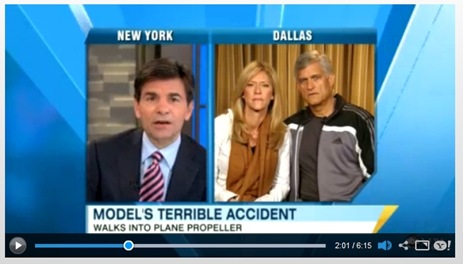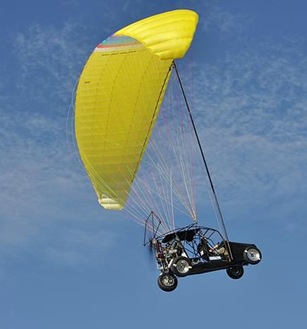Christmas will be here in less than two weeks and in case you are a non-pilot who has not gone out and bought a present yet for the special pilot in your life (or perhaps you are a pilot who wants to drop a few hints), Jason Schappert of the MzeroA blog has put together a short video with three great stocking stuffer ideas. Jason’s three gift ideas? The Airshow America DVD, Pilot Life T-Shirts and of course, his new book: The FAR/AIM In Plain English.
Model walks into a spinning propeller blade
Apparently over the weekend, Lauren Scruggs, a fashion blogger / model accidently walked into the blades of a spinning propeller after a night flight to view Christmas lights in Dallas. The victim will survive but she did end up loosing a hand plus suffered severe injuries to part of her face and shoulder.
Its not clear how the accident happened but her parents believe she went back to the aircraft to thank the pilot when she inadvertently walked into the spinning propeller blades.
Nevertheless, the accident shows both pilots and their passengers alike the need to be extra careful, especially at night, when entering and exiting propeller driven aircraft. In other words, be extra cautious and mindful when that propeller is spinning and tell your passengers to not enter or exit the aircraft until it has stopped.
Build your own Spitfire
Owning a genuine airworthy Spitfire would be out of reach for most aviators but nevertheless, there is another option available: You can build your own Spitfire. In fact, General Aviation News has a lengthy article where Mike O’Sullivan, the CEO and founder of Supermarine Aircraft, talks about the kits his company sells which allow would-be fighter pilots to build a 90% scale replica Spitfire.
Mike noted that if you wanted to find an original Spitfire, you might need to pay as much as $300 million but his replicas cost closer to $300,000 and take an average of about 1,200 hours to build. Moreover, all of the prefabricated metal components are pre-cut and pre-drilled using a computer-controlled cutter to ensure uniformity of all parts – making the aircraft easy to assemble.

However, cockpit instrumentation is completely up to the builder who can even opt to install a glass cockpit into their Spitfire but apparently most builders stick to more authentic steam gauges. Likewise, paint is also up to the builder with most choosing a known design that was used during the war.
As for Mike’s aircraft, his is blue and it has an American flag and the name High Lady emblazoned on the side. Apparently, the aircraft pays homage to a Spitfire that was the first one to fly over Berlin on March 6, 1944 right after the first American bombing raid on the city.
Moreover, it may come as a surprise to many World War II buffs that Americans were flying Spitfires during the war. In fact, High Lady flew as part of an American squadron that had 250 Spitfires – all flown by Americans.
If you want to learn more about how you can build your own Spitfire, check out the website of Mike’s company at SuperMarineAircraft.com. Also included on the website are plenty of pictures and videos.
Introducing NeverWet: Nanotechnology to keep your plane dry
EAA has recently mentioned NeverWet – a product based on nanotechnology that might one day be your aircraft’s only answer for how to repel water, prevent icing and stop corrosion. Not only that, NeverWet could even make your aircraft self-cleaning. Just take a look at this short demonstration video about the new technology:
NeverWet is the result of three years of work by a dozen scientists working for Ross Nanotechnology, a division of Ross Technology Corporation in Pennsylvania. Ross Technology sells steel products and they were looking for a way to reduce corrosion on these products. When the company could not find a suitable coating, a Nanotechnology division was formed.
Specifically, the product developed is a silicon-based coating that conceivably has endless consumer and industrial applications – include applications for general aviation.
So how does NeverWet work? Under normal circumstances, hydrophilic surfaces (e.g. metal) have a high surface energy and a low contact angle – meaning water will spread across it without forming droplets. A perfectly superhydrophobic surface will force the water to bead into a sphere with a 180-degree contact angle while a newly waxed car and Teflon will have contact angles of 90 degrees and 95 degrees respectively. However and according to its developers, NeverWet has a contact angle ranging from 160 degrees to 175 degrees.
In other words, NeverWet forms an air barrier between water and corrosion. Moreover and if its applied inside a pipe or tube, the liquid inside will move faster as its rubbing against air rather than the side of the pipe or tube.
NeverWet will be available next year and its developers are planning both a spray and a paint. Hence and for general aviation, just imagine the possibilities (if the product works as its developers claim it does): No more worry about ice forming on the wings, less drag or corrosion from water and easier cleaning of bugs or dirt.
A flying dune buggy enters production
The AOPA Pilot Blog has reported that a company called Itec/Beyond Roads has just delivered four of its “Maverick” powered-parachutes that come with a drivable dune buggy or off-road vehicle that is used as a cockpit. Although I would have guessed that it would be hard to call the device a true aircraft, they are actually approved to be light sport aircraft (LSA) – a category that also covers powered parachutes.
Specifically, the company has some how managed to receive government approval for the “car” aspect of the design by getting it approved as a kit car. This loophole surprised other companies trying to get their “flying car” concepts approved and able to pass highway crash standards.
However and while the media is calling the Maverick a flying car, its actually intended to be a jungle dune buggy that can hop over water obstacles. Moreover and if there is no headwind, the Maverick can drive faster than the 40 mph it gets while in the air (Click here to get all the specs).
On the other hand, there are two catches for would-be buyers:
- The company is very cautious about deliveries and they are only made to experienced customers. One will be going to Dubai (company reps will also go there to provide training to the buyer) and there are nine more being built in Florida.
- Insurance, as you might have guessed, does not come cheap. In fact, the current premium is $8,000 a year for the factory to cover its personnel and to give demonstrations.
Nevertheless and if you have ever wanted a dune buggy or an off-road vehicle that can fly for the next time you visit a jungle or desert and need to clear a hazard, the Maverick might just suit your needs.
BALPA’s campaign against EU pilot rules
Recently, the British Airline Pilot’s Association (BALPA) put together a video to oppose less stringent EU rules regarding Flight Time Limitations (FTLs) from being imposed on UK airline pilots (there is also an online e-petition that supporters can sign). BALPA has also put together the following graphic comparing and contrasting the UK rules with their EU counterparts:
And while most viewers of the video’s Youtube page seemed to like the video and support its message, not all comments were positive. One viewer wrote that this will be “Another step to fully automated cockpit WITHOUT pilots” while another viewer wrote that the video is a typical case “where somebody with an agenda (like a union striving to get pay raises) is playing on people phobias (like the fear of flying or, more recently, fashionable anti-EU sentiments).” Finally, one very critical viewer wrote:
Pah! If the dictate was HALF hours and HALF pay for ‘Safety’ – they’d strike! Misleading graphics – iffy ‘facts’ Some work hard, some not, many I know have it cushy. UNIDENTIFIED “independent research”? Meaningless! “4x the legal blood alcohol limit for flying” showns as 4 PINTS?? A Nonsense! An intended to shock deception which discredits this. When were standards set ? Modern craft have such reduced workload to those of old..maybe we need hours for different types steam/glass etc.
Hence, we want to ask you our readers what you think: Is BALPA right or is this just a case of a pilot union trying to rip up anti-EU hysteria to preserve the status-quo?


